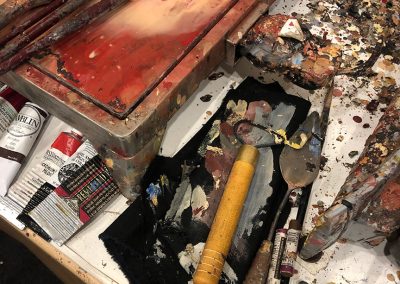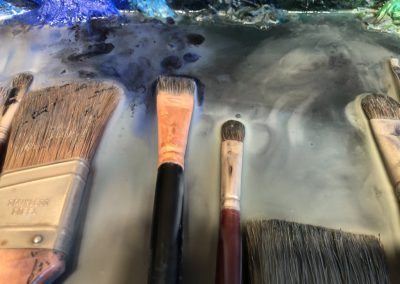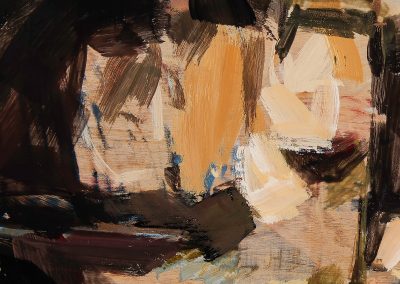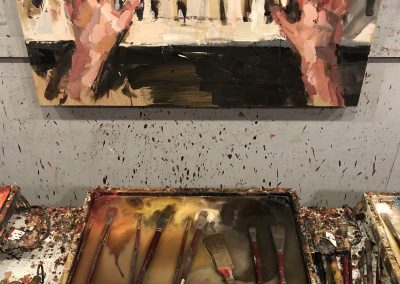ABOUT ENCAUSTIC PAINTING
Encaustic painting is a wax-based painting medium characterized by luminous color and a sensual surface, originating in Ancient Greece and Greco-Roman Egypt 2,000 years ago. The Fayum funerary portraits are beautiful examples of encaustic painting that has survived to today. After virtually being forgotten with the advent of easier painting mediums such as oil and tempera paint in the middle ages, it is quickly regaining popularity and it is used in a wide variety of ways by contemporary artists today.
The word encaustic originates from the Greek word enkaustikos meaning “to heat” or “to burn”. It is the technique of painting with hot pigmented wax. A painting medium is used of beeswax and a small amount of damar resin for hardness. Pigments are added to give it color in the form of dry pigment, oil paints, and pastels. Hot plates with fry pans and griddles are most often used to heat the wax for application. Wax can be applied with brushes, spatulas, or scrubbed, dabbed, dripped, or poured. The artist must work quickly and decisively as the wax begins to cool the moment it leaves the heat source. The artist can then use heat to manipulate the paint further by reheating it with a heat gun or torch or by using a heated palette knife or work the paint in its cool state by scrapping and incising with a sharp tool. Objects can even be embedded in the wax. It is a very versatile medium and so there is a wide range of painting results.
I was in art school when I started to notice paintings in galleries that attracted me for their luminous quality. These pieces were encaustic. After graduation, I began exploring painting with encaustic (We were not allowed to have a hot plate our studios in art school). It was not an easy start, it took many tries and giving up before it seemed to click with me and it became a natural way of working. Now I paint exclusively with encaustic. I was trained as an oil painter and I have carried some of the techniques over to the encaustic process and over time I have developed my own system of working that uses both the oil and encaustic worlds. I use a griddle as a hot palette and I use oil paint, dry pigments, and encaustic blocks of colors. I make my medium out of bleached beeswax, dammar resin, and carnauba wax. I melt wax medium on the griddle and mix in my color. I paint with a bristle brush, use a torch to re-warm the paint and use a potters loop tool to scrape. Would you like to see it in person or take a lesson or workshop? Please visit my Contact and Lessons pages. All of these things are possible.
CARE OF AN ENCAUSTIC PAINTING
An encaustic painting is durable and archival, due in great part to the fact that beeswax is impervious to moisture. There are many examples of encaustic paintings which have survived from ancient Greek and Roman times and which are almost as vibrant and fresh as if they were painted yesterday.
However, there are some things to be aware of when caring for an encaustic painting.
As with all art forms, encaustic paintings should not be exposed to direct sunlight or extreme temperatures and care should be used when hanging, transporting, or storing. Avoid freezing and extremely hot temperatures. Hang and store at normal room temperatures. They will melt at about 150 degrees Fahrenheit or 65 degrees Celsius.
Please be aware that the surface of a painting can be scratched, or chipped. The edges of encaustic paintings are especially vulnerable to chipping. Take care when moving or transporting an encaustic painting.
A floating frame is a good protection for the edges and it is your best option as a framing presentation as it protects the edges and still allows for you to view the complete painting. Encaustic paintings on panel do not need to be varnished or protected by glass. If they are painted on paper or museum board or other similar support they should be framed under glass like all works on paper.
An encaustic painting may develop “bloom” (a naturally occurring hazy white residue) during the first six to twelve months as the wax cures. It may also occur if a painting is exposed to cold. Bloom can easily be removed by wiping the surface of the painting with a soft cloth or if the painting is more textured, the use of a hairdryer will remove it. Buffing or use of a hairdryer can be repeated as necessary.
If needed, the surface of an encaustic painting can be dusted with a soft cloth.
If you have questions do not hesitate to contact me here.
AN ENCAUSTIC PAINTING FOR A 16TH WEDDING ANNIVERSARY GIFT
Did you know? A 16th wedding anniversary gift traditionally has the element of wax. That means an encaustic painting is the ideal gift. I also paint quite a few paintings for couples even when it’s not their 16th anniversary.





